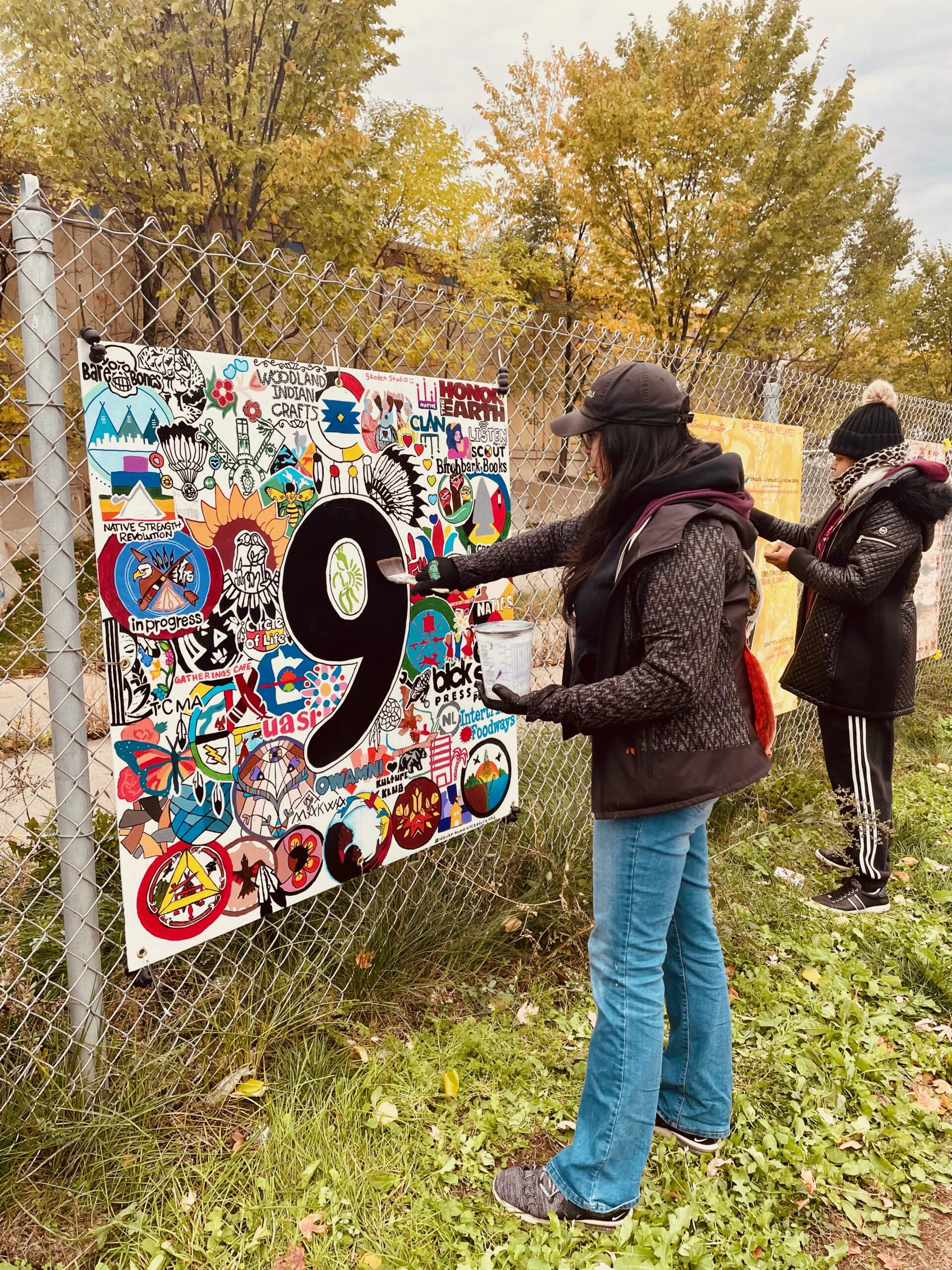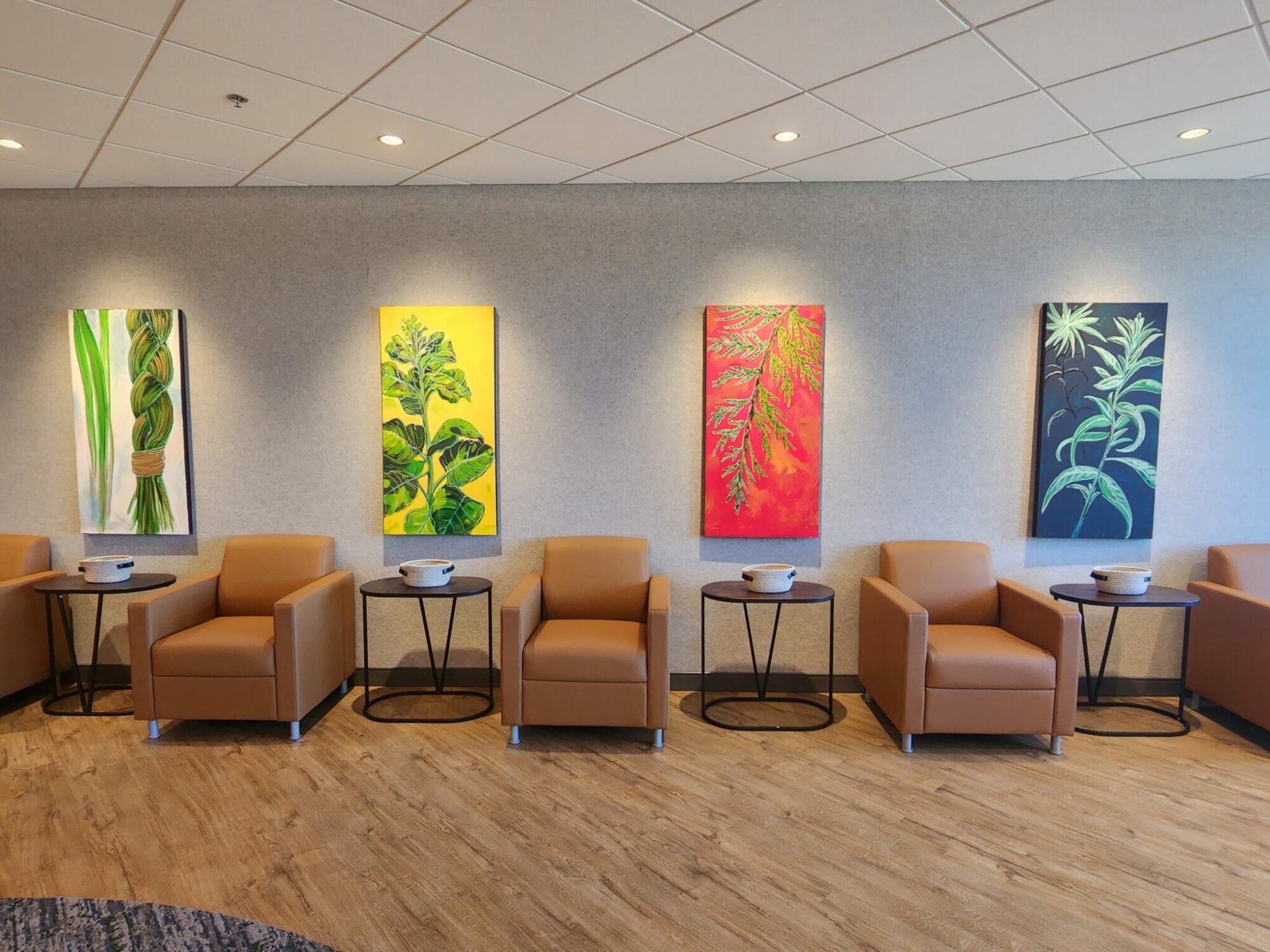Arts Consulting Projects
Our Work in the Community
Art and culture are fundamental to our strategies for community advancement. Arts and culture plays a major role in building and transforming the Native community and is the primary focus of AMRA. The gallery is a vital gathering space for creative community engagement, education, and outreach to our neighbors and allies. Our programs are a point of access for professional development of artists and curators as well as an entry point for shared Indigenous understanding across cultures.
AMRA offer consultation in a variety of ways for our communities. Please contact us and let us know how we can be helpful.

Never Homeless Before 1492, by Courtney Cochran
In 2018, one of the largest homeless encampments in the history of the state of Minnesota developed on MnDOT’s highway right of way in Minneapolis in the American Indian Cultural Corridor on TH55/Franklin Avenue. The site was eventually occupied by between 200-300 residents, and many of the residents of the camp were American Indians representing many tribal affiliations. The encampment had difficult public health conditions, multiple deaths and fires. Residents of the camp deemed the adjacent noise wall the Wall of Forgotten Natives and an emotional connection to the site was felt by many.
NACDI partnered with the Minnesota Department of Transportation in the creation of a temporary art installation located on the chain-link fence currently at the site of The Wall.
NACDI/AMRA contracted artist Courtney Cochran to lead the artistic design, community engagement, and community art fabrication of the project. The artwork is composed of 23 4’x4’ fluted polymer panels that each have a letter in the foreground and visual imagery of a relevant Native topic or theme in the background. When affixed to the fence the letters spell out, “N-E-V-E-R H-O-M-E-L-E-S-S- B-E-F-O-R-E 1-4-9-2”.
This artwork is an acknowledgment of the experiences of those impacted by the housing crisis in 2018 which led to the Wall and addresses the issues causing homelessness within the Native community. The artwork remembers what happened at the site while also celebrating traditional Native values, lifting up Native voices, and encouraging dialogue on contemporary issues from a Native perspective that are impacting the ongoing housing crisis in urban Native communities. The artwork will remain on display for a period of 2 years while the 55 bridge undergoes re-decking restoration.
“Since 2018, the Franklin-Hiawatha encampment site, known as The Wall of Forgotten Natives, has been central to community dialogue and action addressing American Indian homelessness in a culturally responsive manner,” said Jessica Oh, MnDOT Strategic Partnerships Director, Sustainability and Public Health Division. “MnDOT listened to community and stakeholder feedback and conducted additional public engagement and we are pleased to collaborate with NACDI and Courtney Cochran on this project to elevate the voices of unsheltered Native community members, support community-art making and create space for healing around this important site in the American Indian Cultural Corridor.”
About the Artist
Courtney Cochran is an Anishinaabe multidisciplinary artist, filmmaker and community organizer based in Minneapolis. Her approach to documentary filmmaking comes from a decolonized lens where she abandons the use of the camera as an authoring mechanism and works against any directorial or production hierarchies. Outside of her film practice, she is a teaching artist, jewelry maker, painter and screen printer and often incorporates mixed media elements into her designs.
Her work often addresses issues and ongoing effects of injustices and colonialism inspires healing through creative collaboration, to restore traditions, and to foster connectivity across divides.
MnDOT
The Minnesota Department of Transportation oversees construction and maintenance of about 12,000 miles of roadway in Minnesota as well as all other modes, including land, water, air, rail, transit, walking and bicycling. MnDOT is responsible for maintaining a safe, accessible, efficient, and reliable multimodal transportation system that connects people to destinations and markets throughout the state, regionally and around the world.

Artwork installation by Moira Villiard in Hamm Clinic’s waiting area.
Hamm Clinic Partnership with Artist Moira Villiard
All My Relations Arts has partnered with Hamm Clinic to create an artist-led community artwork installed in the lobby of Hamm Clinic’s new building located in Saint Paul. Hamm Clinic’s intention in the commissioning of this artwork is to celebrate the Indigenous Peoples’ land now occupied by Hamm Clinic and serve their mission to promote mental health with culturally responsive, relational care for adults. Artist, Moira Villiard (Fond du Lac, direct descendent) was selected to lead the design and fabrication of the artwork.
Through positive, spiritual and cultural foundations facilitated by elder advisor, Mildred Richard, Moira Villiard and AMRA hosted a series of community conversations exploring the topic of mental health, how it impacts our communities, and ways in which we can achieve healing and recovery. These conversations were utilized by Moira as inspiration for the development of her designs for the final artwork, which is meant to uplift, comfort and call attention to traditional Indigenous medicines and healing.
About the Artist
Through public art collaborations across Minnesota, Moira Villiard (pronounced “Miri”) is a multidisciplinary artist with a mixed Indigenous and settler heritage who uses art to uplift underrepresented narratives, explore the nuance of society’s historical community intersections, and promote community healing spaces. Moira is a dynamic visual artist, proficient in a variety of artistic genres, including portraiture, illustration, graphic and digital design and as a muralist. She is also a community organizer, curator and passionate arts educator concentrating her efforts around issues of equity and justice including: arts access (creating platforms for underrepresented communities within the arts), creative placemaking, environmental sustainability, youth empowerment, and acknowledgement of Indigenous land, culture, and history.
Moira grew up on the Fond du Lac Reservation in Cloquet, MN and is a Fond du Lac direct descendent, Lac Courte Oreilles Band of Ojibwe lineal descendant, and Moravian Band of the Thames Lenape direct descendant. For three years she worked as the Arts & Cultural Programming Coordinator for the American Indian Community Housing Organization (AICHO), the place where she had her first art exhibition at 18 years old. She currently works as a freelance consultant, designer, speaker, and grant-writer and is the project director and lead artist of the Chief Buffalo Memorial Mural site in Duluth. Her educational, activism-rooted exhibits “Rights of the Child” and “Waiting for Beds” will be on tour in 2023.
In 2021 she debuted her first animated work for Illuminate the Lock, a 10 minute, 150’ projection piece titled “Madweyaashkaa: Waves Can Be Heard”, and has since collaborated with Indigenous musicians and writers to create animations for “A Winter Love”, “Mináǧi Kiŋ Dowáŋ: A ZitkálaŠá Opera”, “Jonathan Thunder: Good Mythology” (PBS American Masters), and “Extraction” (poem by Tanaya Winder), among other films.
Her work has been featured in numerous shows in Duluth and around Minnesota, including her recent solo show, “Rights of the Child” at Zeitgeist, and group shows “Beyond Borders” at MacRostie Arts Center and “We the People” at the Minnesota Museum of American Art. She received her Bachelor’s Degree in Communicating Arts (Global Studies Minor) from the University of Wisconsin-Superior in 2016 and an Associate of Liberal Arts degree from Fond du Lac Tribal & Community College.